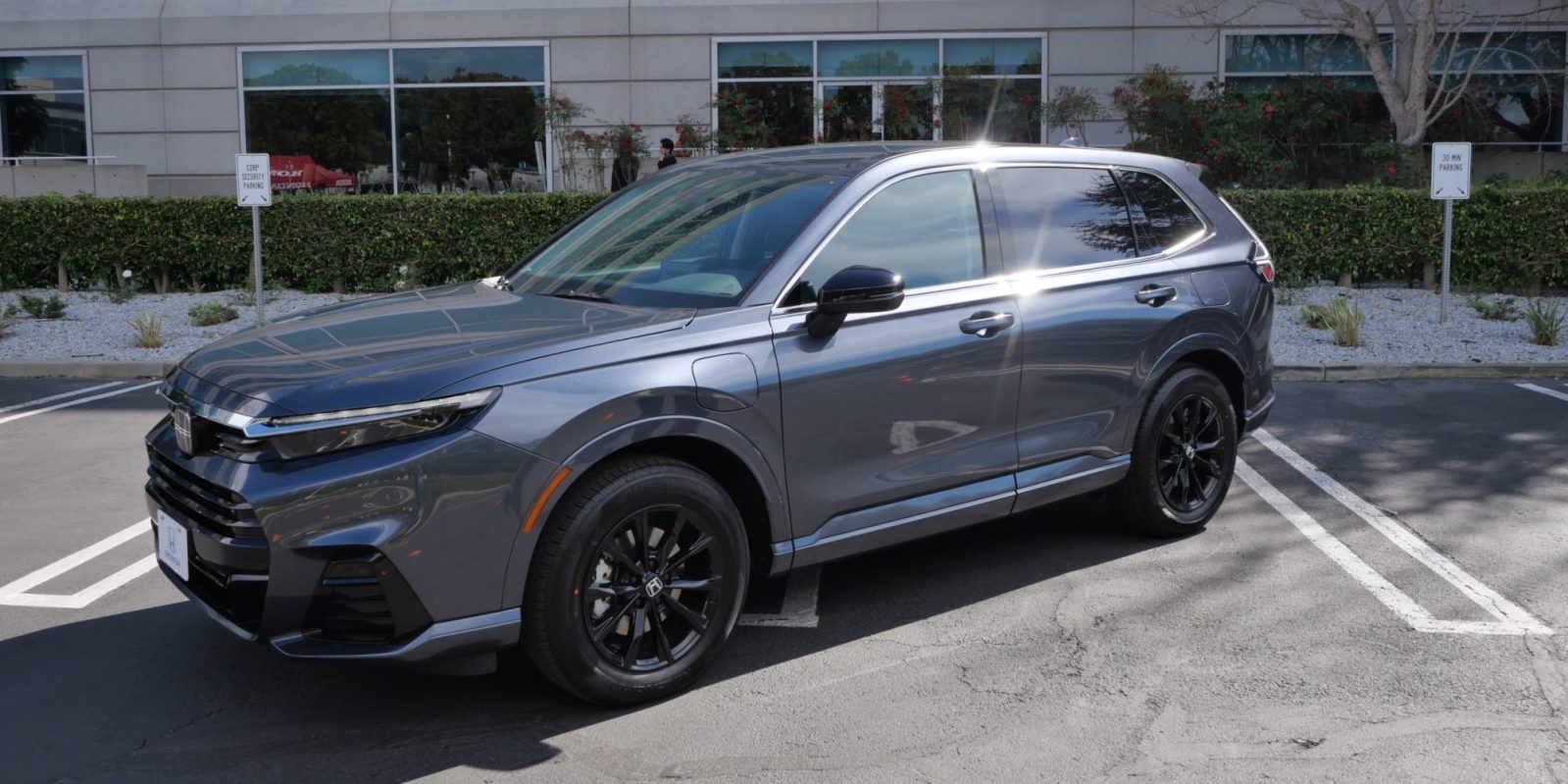
Honda invited us out to its US R&D Center in Torrance, California to drive the new fuel cell plug-in hybrid version of the CR-V, which gets released later this year. Is this first-ever hybrid between a battery EV and fuel cell EV the future of electric cars?
Honda’s CR-V e:FCEV (say that ten times fast) is the first in a new generation of Honda’s fuel cell technology, much improved over the hydrogen fuel cells in its earlier fuel cell vehicles, the FCX and Clarity (the Clarity’s fuel cells are now being used for stationary power generation applications).
The new generation reduces cost and increases durability, using fewer rare elements and giving better cold weather performance, among other improvements.
This fuel cell stack has been paired with a 17.7kWh battery, much larger than that on most fuel cell vehicles, good for about 29 miles of battery-electric range, and 270 miles of total range. Most FCEVs have a small battery to act as a buffer between the fuel cell stack and the electric drive units, but the e:FCEV expands on that to offer an actual traction battery that can be recharged by plugging the car in.
It’s a novel solution, which we haven’t seen in any other vehicles yet. And there are some ways that this works – a FCEV is an EV anyway, and has a buffer battery regardless, so you’re not changing much in terms of complexity by just making that battery big enough to drive the vehicle on its own. And you are certainly adding more practicality, potentially allowing daily driving to be done on electric and keeping hydrogen fillups less frequent.
But a novel solution may or may not be the right solution. So, is this e:FCEV the next big thing, or just an interesting one-shot?
Honda CR-V e:FCEV First Drive
I’m going to try to keep the drive segment short (update: whoops, I didn’t), because I think there’s more interesting discussion to be had around the philosophy of this vehicle, rather than the actual implementation of it. We’ll get to that.
At its core, the drive experience of the e:FCEV is quite similar to that of Honda’s regular gasoline-powered hybrid CR-V. The CR-V is Honda’s most popular vehicle and one of the best-selling cars in its segment (behind the RAV4 and Model Y), so it’s a pretty known quantity here.

The exterior looks extremely similar to the gas CR-V, though if you know what you’re looking for you’ll be able to see differences. These are mainly in the longer front overhang, different grille (larger on the FCEV than hybrid – for more cooling, oddly enough), and different taillights. Plus the lack of exhaust pipes, of course.
The interior is very close to the existing CR-V, but uses some upgraded more-sustainable materials, which should be attractive to the likely more-sustainably-minded customer base that Honda is looking for with this car (though this leaves one to wonder: if these materials are more sustainable, why can’t Honda just use them on the gas versions of the car, where much higher volume will have a bigger effect on overall sustainability?)
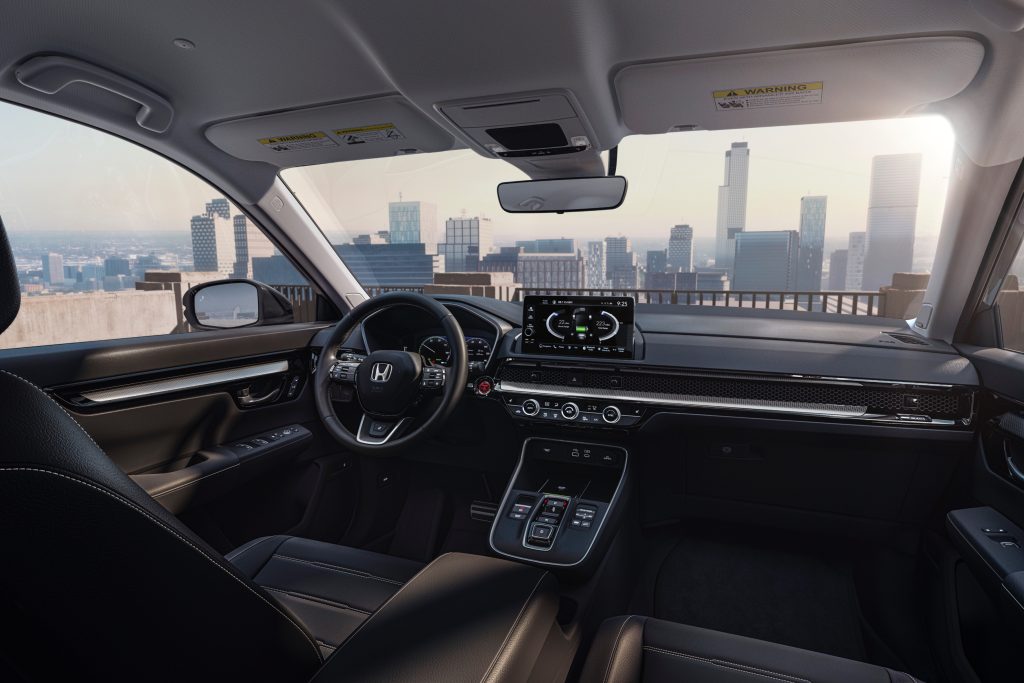
I do quite like the “honeycomb” dash pattern, where the air conditioning vents live. It’s a cool-looking design feature, and reasonably functional as well. Though it seems like it could be tough to clean or repair.
The screen is 9 inches, and has wireless CarPlay and Android Auto, which you’ll probably stay in most of the time unless you want to look at the “energy flow” display to get a sense of whether the battery or fuel cell is currently powering the vehicle.
The biggest interior change is in the rear, where the hydrogen tanks have been placed behind the seats, meaning a significant chunk has been taken out of the rear cargo area.
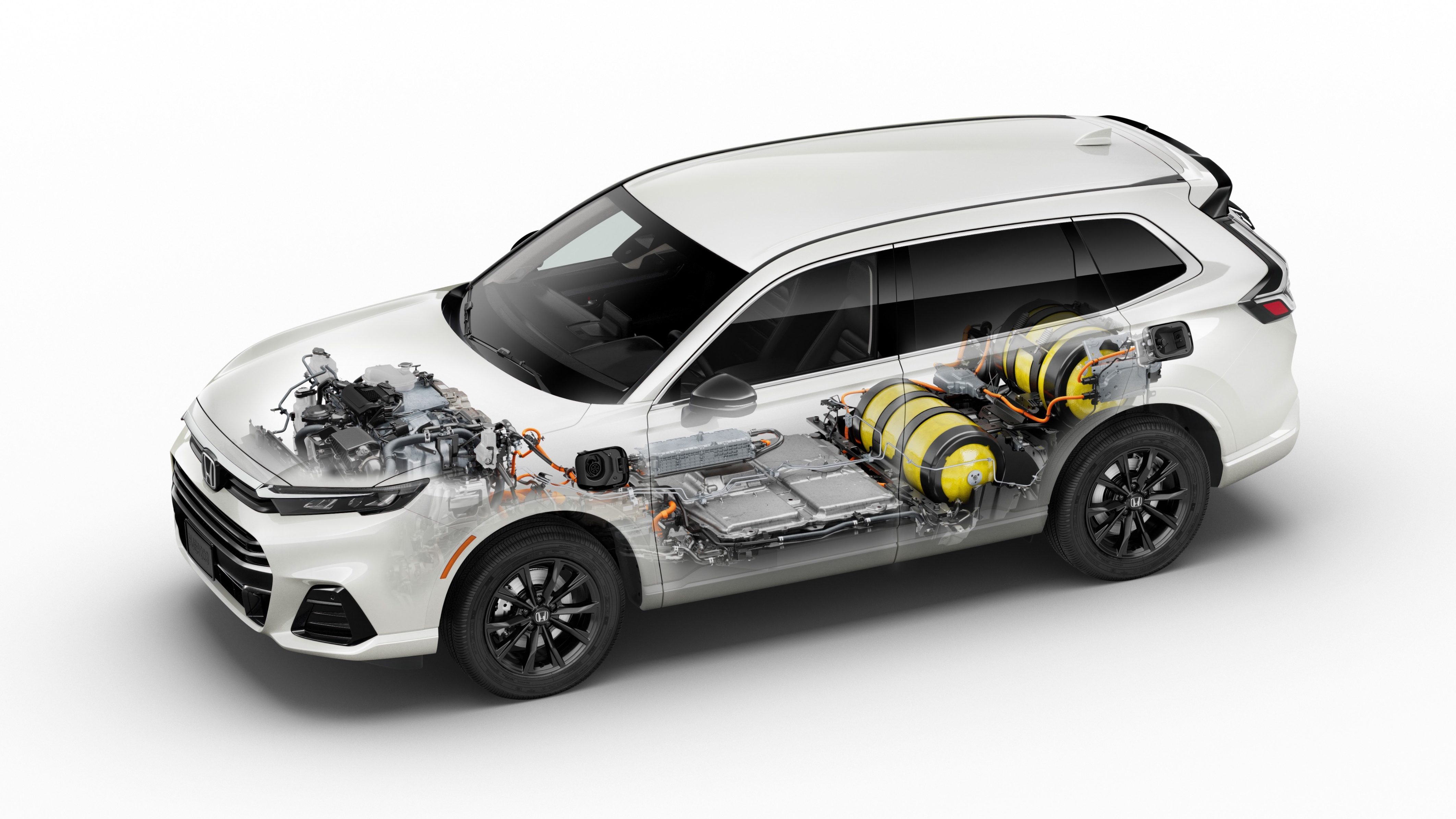
Honda’s solution to this is pretty clever, turning the rear into a two-tier cargo area. By lifting a shelf from the loading floor and placing it on rails behind the tank area, the upper cargo area is made flat with an additional storage cubby underneath. Rear seats can be folded down to make a longer flat cargo area, which Honda said is plenty enough to hold a bike (and then, you’ve still got room under the shelf for a bag, or groceries, or whatever).

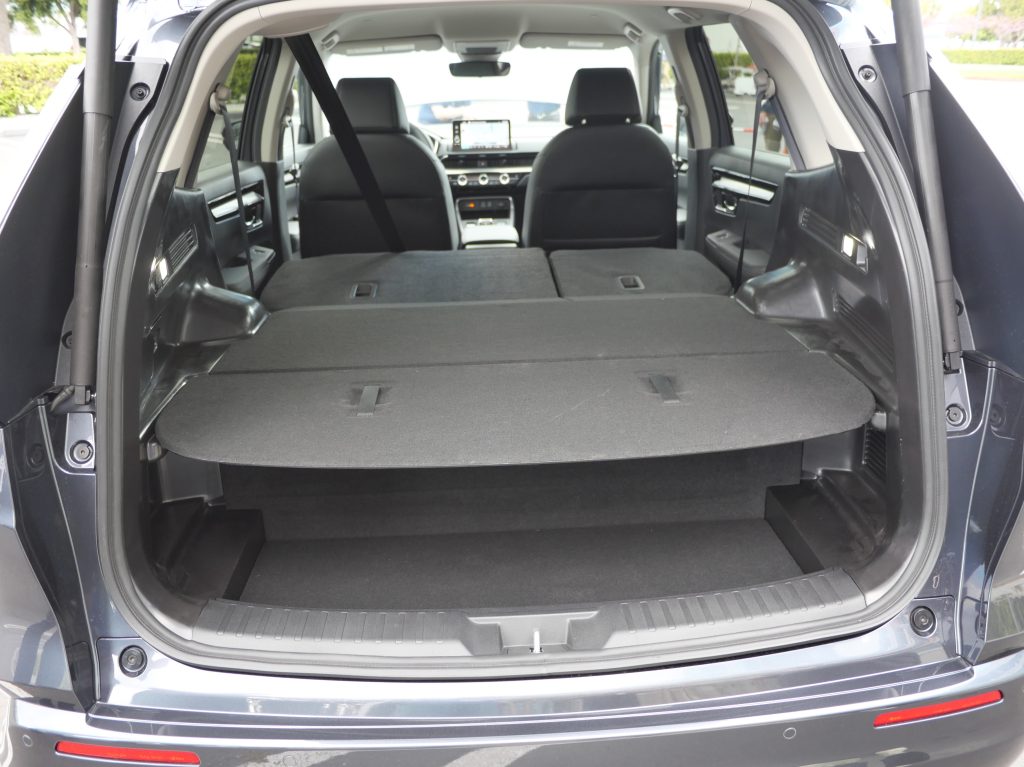
Otherwise, the interior is comfortable, functional, and nice. You get what you think you would get out of the third-best selling car in America’s most popular segment – nothing funky like a drop-down 27″ TV or “taco trays.” just the sort of workmanlike effort one would expect out of Honda.
But this familiarity also means the experience is similar to gas Hondas, which is something that we, the EV faithful, have mostly moved beyond. To start up the car, you need a key (gasp), you need to put your foot on the brake (okay), you need to press a start button (gasp), and you even need to turn it off when you get out (riot!!).
When you do press that “power on” button, you can hear the car “start up” with a distinctive (and honestly pretty cool) “whoosh” sound, more audible outside than inside, which is the sound of the fuel cell stack sucking in air to be used in the fuel cell reaction. This reaction combines hydrogen gas stored in an onboard tank (H2) with oxygen (O) extracted from the air to form H2O, plain water. This water exhausts (drips) from a small pipe near the tire.
The car’s accelerator pedal is responsive, but power is not that strong (and despite that, it’s still pretty easy to chirp the tires with the front-wheel drive powertrain). Peak power is 174hp (130kW), about 80kW of which comes from the hydrogen fuel cell stack (after accounting for system losses). The remainder comes from the battery, though this is also dependent on battery state of charge, so you’re going to end up somewhere in the mid-100s in terms of peak horsepower.
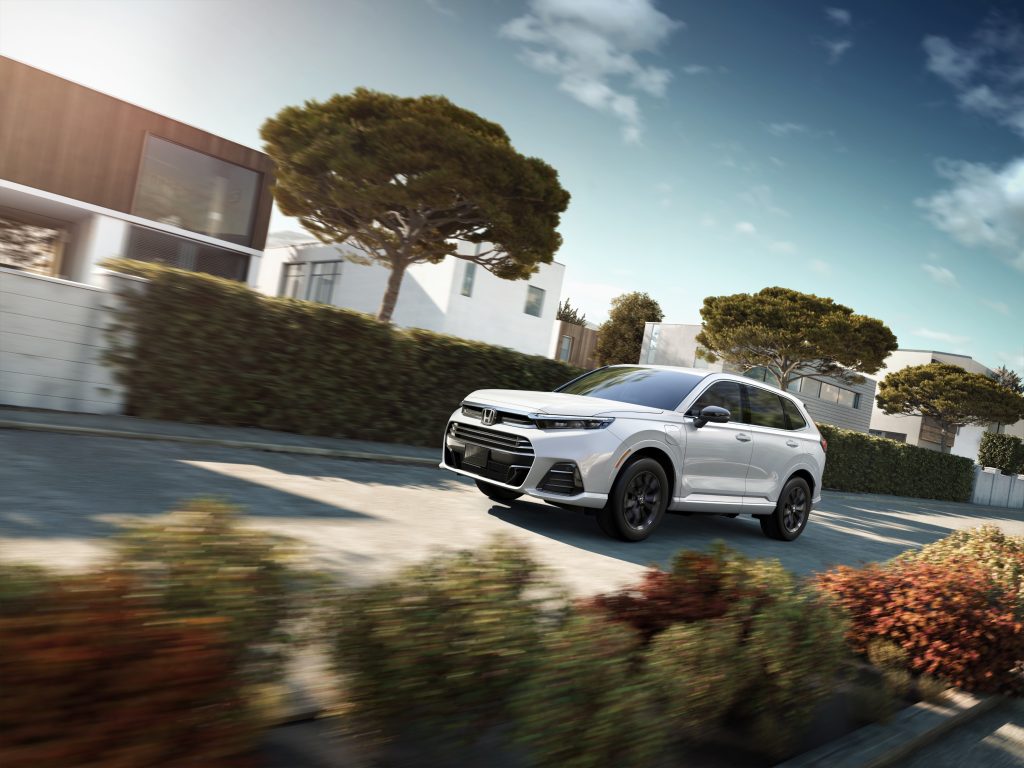
So it’s not that much oomph, especially given the ~500 extra pounds the e:FCEV weighs over the hybrid CR-V (Honda didn’t have a final curb weight number for us, but it sounds like it’s somewhere in the ~4,300-4,400lb range).
If you’re looking for a punchy, sporty, electric acceleration experience, you won’t get it here. But if you’re looking for something a little more responsive than your midsize gas SUV, and that can get up to speed without as much choking drama from a gas engine, then the e:FCEV could offer a pleasant change.
Modes upon modes
The car has four drive modes: Sport, Normal, Econ, and Snow. These modes change throttle mapping and “smooth out” accelerator inputs, with some modes reducing the power used by the HVAC system. Sport mode also comes with “Active Sound Control.” We’ll get to that in a moment.
In practice, like with most vehicles, I found that I liked sport mode the best. This is not because it’s the fastest, but because I want control of my vehicle. I do not want my throttle inputs artificially slowed down (if I wanted that, I’d drive a slow gas car), I don’t want to be missing the full power at full throttle, and I don’t need a car to force me to drive economically because if I wanted to do that, I can just lift my foot a little and get the same results as if I was in “Econ” mode.

But the problem with this is that sport mode’s “Active Sound Control” makes it sound like there’s a gas engine in the car. It’s not as loud, rumbly and disruptive as the actual gas engine in the hybrid, and it doesn’t sound exactly like a gas engine, but the pitch is closer to a gas engine than most “fake EV noises” we’ve heard, and doesn’t sound very “futuristic” (for the record: those noises are also dumb).
There is no way to turn off this sound in sport mode, but at least it’s only present in sport mode. If you want to drive in the most responsive drive mode, you have to listen to an MP3 file of motor noise whenever you accelerate or decelerate.
Regenerative braking: no one-pedal
Deceleration comes in the form of a blended brake pedal, which activates regen or friction brakes depending on how far down you’re pressing it, or in the form of regenerative braking which is accessible through paddles behind the steering wheel.
Though unlike many EVs where these paddles allow you to set a regen level and then forget about it (whether for that drive, or permanently), the regen level on the e:FCEV resets a few seconds after you stop using it. So this means that every time you stop the car, you need to press the paddle for the car to remember your regen settings.
This method, again, is a carryover from the hybrid CR-V, which has similar paddle operation. You could think of it more like paddle shifters on a manual transmission vehicle, controlling the amount of engine braking you’re getting.
But any setting isn’t particularly strong in the regen department, and even in the maximum “D with four down-arrows next to it” regen mode, the car is not really meant for one pedal operation. And it has a creep which can’t be turned off (though there is a brake hold button).
EV vs. fuel cell mode
So that’s two separate modes, drive mode and regen mode. But there’s another mode selection, e-mode, allowing you control over which powertrain you’re using. This lets you either drive fully on “EV”, to “Save” your battery level, to “Charge” your battery, or to let the car figure it out on “Auto.”
In practice, we tried to start in EV mode and immediately dropped out of it and were unable to switch back into it. The car only has limited power in EV mode, because the battery doesn’t put out as much power as the fuel cell stack. So if you ever call for more power than EV mode can provide (which car journalists are obviously going to do during a test drive), the car kicks into Auto mode. And since fuel cell stacks don’t like to be turned on and off all the time, once you’ve turned it on, it stays on for that whole drive, until the car is powered down.
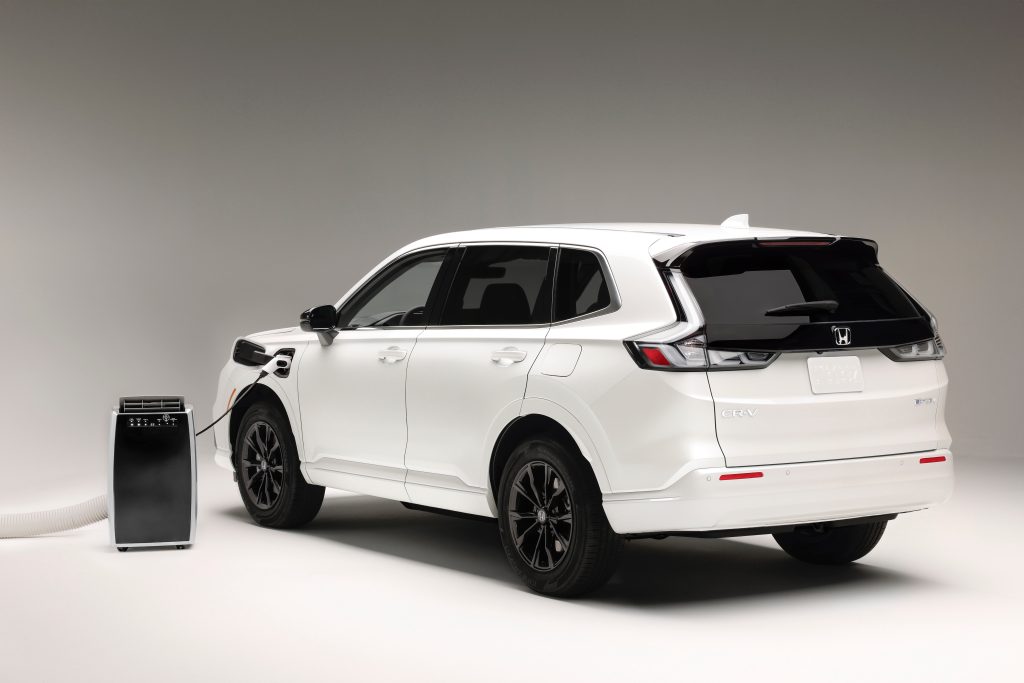
When you’re not in EV mode, the car won’t tell you how much electric-only range you have left, but it will idle the fuel cell stack and use only battery when fuel cell power is no longer required.
So we were having trouble thinking of how these modes would be useful, since it seems like the car will usually be in Auto mode. Honda mentioned that owners would likely get used to the light-foot requirement for staying in EV mode over the course of ownership. One employee said that, with practice, he can easily keep his hybrid CR-V from turning on the engine when he’s just driving a few blocks. I’m willing to believe this.
Honda also said that “save” or “charge” modes could be useful, for example, when you know you’re heading to fuel up at a hydrogen station during a trip, so you can be sure to leave the station with full charge and a full tank.
Wait, a tank?
Okay, so now we’ve described the drive experience, which was… fine. It’s clear that the car is influenced mainly by the gas/hybrid side of things, rather than the EV side of things, and it’s not nearly as punchy as the best-selling vehicle in its class (and the world). But it’s got a nice interior and it gets you around town without trouble.
But the big gray elephant in the room is how you get that energy into the vehicle to begin with, and for the e:FCEV, most of that energy is going to come from hydrogen. And most of that gas comes from another gas, methane (also greenwashingly known as “natural” gas, also known as a greenhouse gas 28x more potent than CO2 that tends to escape when we frack for it) which produces 95% of the hydrogen we get in the US through a process called steam reforming.
So in practice, a hydrogen car is a methane car, at least right now. Well-to-wheel, it offers greater total thermal efficiency (turning fossil fuel energy into forward motion) than a gas vehicle would, but lower efficiency than if that methane gas were used to generate electricity and charge a BEV.

But hydrogen can also be produced through electrolysis of water, where electricity, preferably generated via surplus renewable energy, is run through water to break it down into hydrogen and oxygen. This is the reverse of the reaction that makes a fuel cell work – put electricity into water to break it into hydrogen and oxygen, put hydrogen and oxygen back together to make electricity and water.
This has been called “green hydrogen,” as opposed to the “gray hydrogen” which is the vast majority of current hydrogen production (see more about the confusingly-named “colors” of hydrogen here).
If fuel cell vehicles were fueled by green hydrogen, they would suddenly become a lot cleaner – just like how BEVs get cleaner when fueled by solar rather than coal.
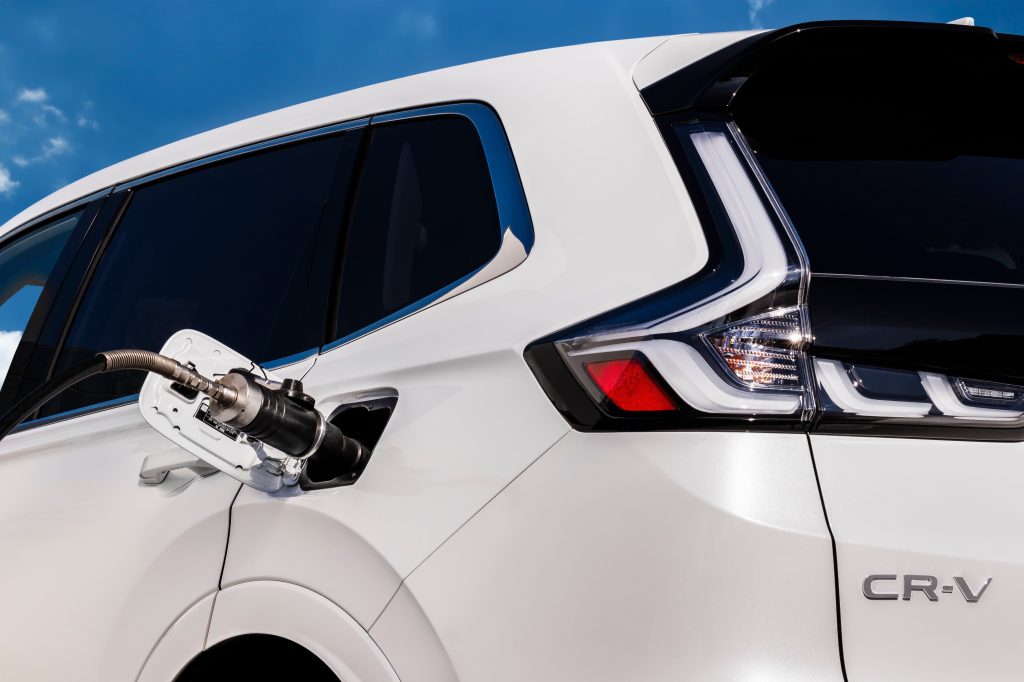
But it’s not as easy to build a hydrogen electrolysis machine in your garage as it is to put up solar panels on your roof. It’s easy enough to make hydrogen through electrolysis, it’s harder to capture it, and it takes a lot of effort to pressurize and store it in the amounts needed to fuel a car. None of these are impossible steps, but there are thousands of solar installers, and not much in the way of home hydrogen pumps (Honda tried it before, using a home’s methane gas lines to produce hydrogen rather than electrolysis, but it didn’t get anywhere – we spied the defunct demo unit in the corner of the parking lot).
So to fill up this car, you’re going to go to hydrogen stations, which so far are getting 95% of their hydrogen from methane. Compare this to ~36% of California’s electricity coming from methane, and dropping.
And why are we comparing to California specifically? Because that’s the only place the e:FCEV will be available. Honda says the reason for this is because California is the only state with a robust network of retail hydrogen stations.
This is true, but California is also the state that requires Honda and other manufacturers to comply with selling a certain percentage of zero emission vehicles or face penalties. This has influenced automakers, including Honda, to release EVs as California-only vehicles in the past (often paired with emphasis on the vehicle’s qualification for a carpool sticker – the e:FCEV qualifies, by the way).
California’s hydrogen stations are largely centered around its two major population centers, Los Angeles and San Francisco, with sparse coverage in The Lands Between.
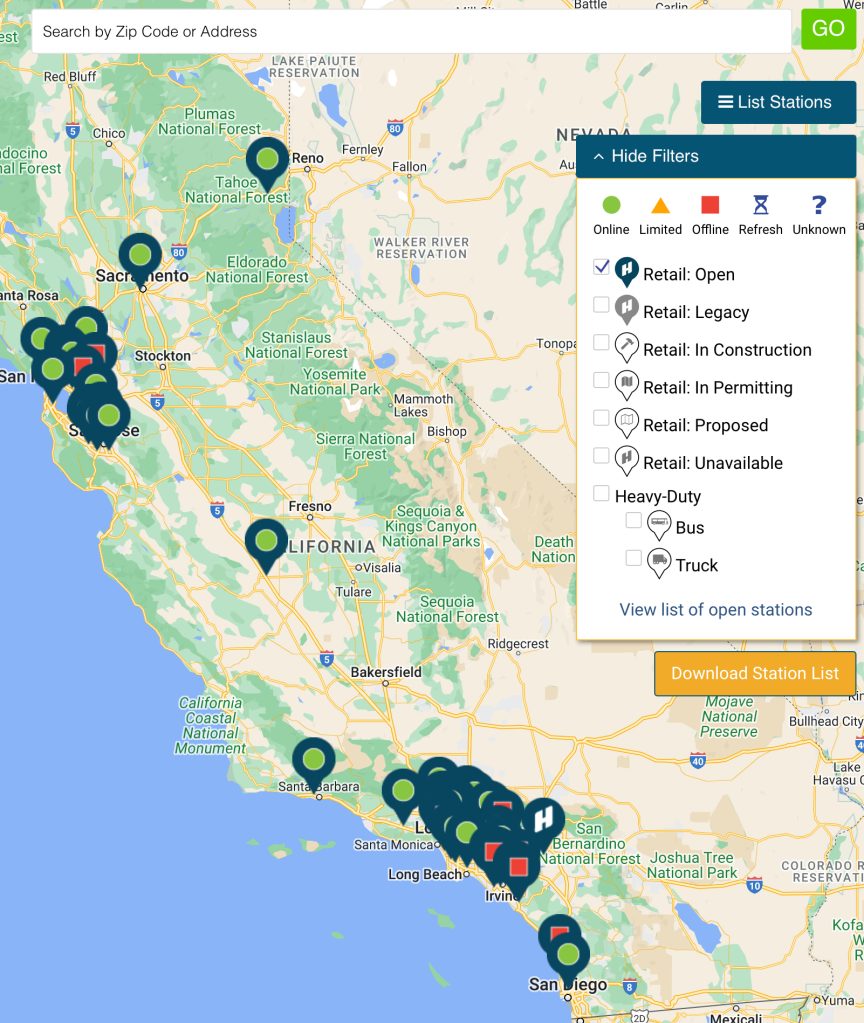
These stations will fill your hydrogen vehicle quicker than an EV on a DC fast charger. Fuel cell advocates say that it only takes about 5 minutes for a fill-up.
In practice, it often takes longer, depending on ambient temperatures, how recently the station has been used by another car, and whether or not there’s a months-long supply disruption which meant half the stations in the state were shut down.
That disruption seems to be over now, but just one month ago Shell decided to shut down its hydrogen fueling stations in the state, which probably doesn’t feel great if your local filling station is suddenly gone and the next one is potentially miles away.
Honda’s philosophy – don’t put all eggs in one basket
Despite these challenges with hydrogen, Honda reminds us that that’s why this vehicle is a plug-in hybrid – in the event that something like this happens, it can still be powered with the battery, and most people can still use it for their daily tasks with 29 miles of battery-electric range, which can be easily charged at any level 2 charger, or even level 1 in a pinch.
This keeps with a philosophy the company repeated several times – that it doesn’t want to commit everything to BEV, like the rest of the industry seems to be doing, thinking that there are applications to which fuel cells would be more suited than BEV.

To be frank, this is a correct statement. There are applications where hydrogen would be a better fuel. Heavy duty and/or long haul applications especially would benefit from higher energy density and faster refueling, and the downside of sparse hydrogen infrastructure wouldn’t be as bad for vehicles with more-fixed routes and planned depot stops (plus, the federal government just laid out a plan to support this). In this vein, Honda is working on bringing hydrogen to commercial trucks, which is a worthwhile effort.
But it is commonly thought that one of the applications where hydrogen is not a better fuel is in consumer vehicles. That is a thought that we here at Electrek tend to share. And in fact, Honda’s CEO Toshihiro Mibe shares it too.
Honda stated to us repeatedly that the case for hydrogen would get better in the long term, even in consumer vehicles, but I don’t see this being the case. Hydrogen infrastructure is sparse yet, is not cheaper or faster to build than plugs, there isn’t as much effort being put into it, there isn’t as much demand for it, and while the cost of a fuel cell stack is likely to come down quite rapidly (Honda has brought costs down 2/3 in this generation alone, an impressive feat), the trend lines just don’t look like they will reach the point where FCEV is the right choice.

In fact, we journalists asked several different ways, and Honda declined to comment each time, about what the price of this vehicle would be, what it costs to produce, when or whether Honda plans to make a profit on it, and so on. All we got was that it would be lease-only and some amount of free hydrogen – which costs ~$36/kg right now, a fuel cost of 47c/mi, about as much as a 10mpg gas vehicle in CA – would be included in the lease. The EV I drove to the event costs ten times less to fuel.
While the question of Honda’s cost to produce these doesn’t really matter (for consumers, price is what matters, and for Honda there can be other considerations too), the underlying implication of our questions was: are you serious about this program? Is it going to last long-term? Is it really part of your business plan? Will it grow fast enough? Or is all of this just a science project?
After all, Honda told us it has been working on hydrogen vehicles for 40 years now, and yet that progress has yielded a vehicle program which plans to sell around 300 vehicles in California per year.
300 vehicles.
In California.
In a year.
Last year, Tesla, a company which has existed for 20 years and been selling volume-produced vehicles for 12, sold 230,589 vehicles in California – one out of every eight cars sold in the state. It sold the best-selling vehicle in the state and the second-best-selling vehicle in the state. All of these vehicles were battery-electric vehicles.
In the same year, Honda sold zero battery-electric vehicles in CA. That will change this year with the Ultium-based Prologue, which Honda plans to start selling in big volume numbers, but the e:FCEV will remain hand-built, in the same Ohio facility that made the hybrid NSX.
We don’t doubt that Honda will find 300 customers for this vehicle, but in a state with over 30 million cars, it’s a rounding error on a rounding error. Honda wants this program to help create demand for hydrogen, so that people will build filling stations. It has invested in First Element, a hydrogen fueling startup, to this end. But it did not commit to building its own hydrogen stations, unlike we’ve seen some other companies do when pushing a new fuel type (that seems to have turned out pretty ok).
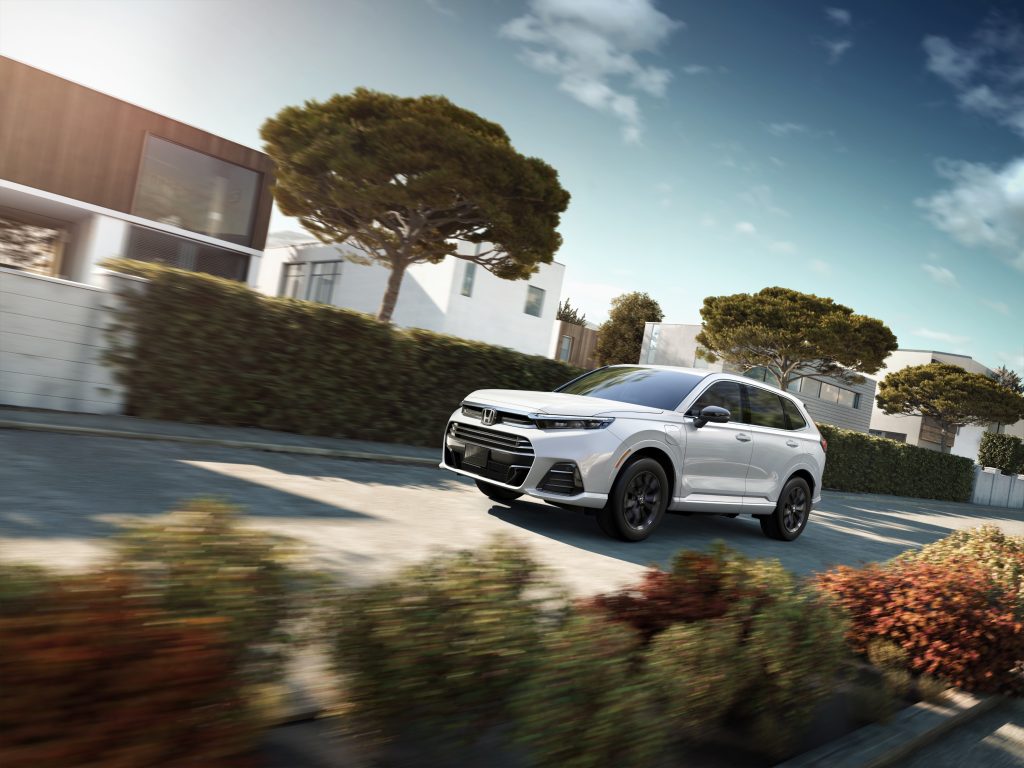
Worse yet, I’ve written a similar paragraph before, about the Mazda MX-30. That was a small-production EV from a Japanese company that was only available in California (though a PHEV version of it was available in Europe) and didn’t meet the moment for the market it was entering. I can’t help but see the comparisons.
Honda says that it wants to be carbon neutral by 2050, with 100% of its new vehicle sales being electric by 2040 (though that will have to be sooner in California, and other states, and Europe). By 2030, it plans to offer 30 new BEVs globally and 15 new BEVs in North America.
But the climate crisis is happening now, and Honda mentioned multiple times to us that it is the largest internal combustion engine manufacturer in the world. This means that it can make the biggest positive impact by changing rapidly, and has a high responsibility to do so, given its products’ outsize fraction of global emissions.
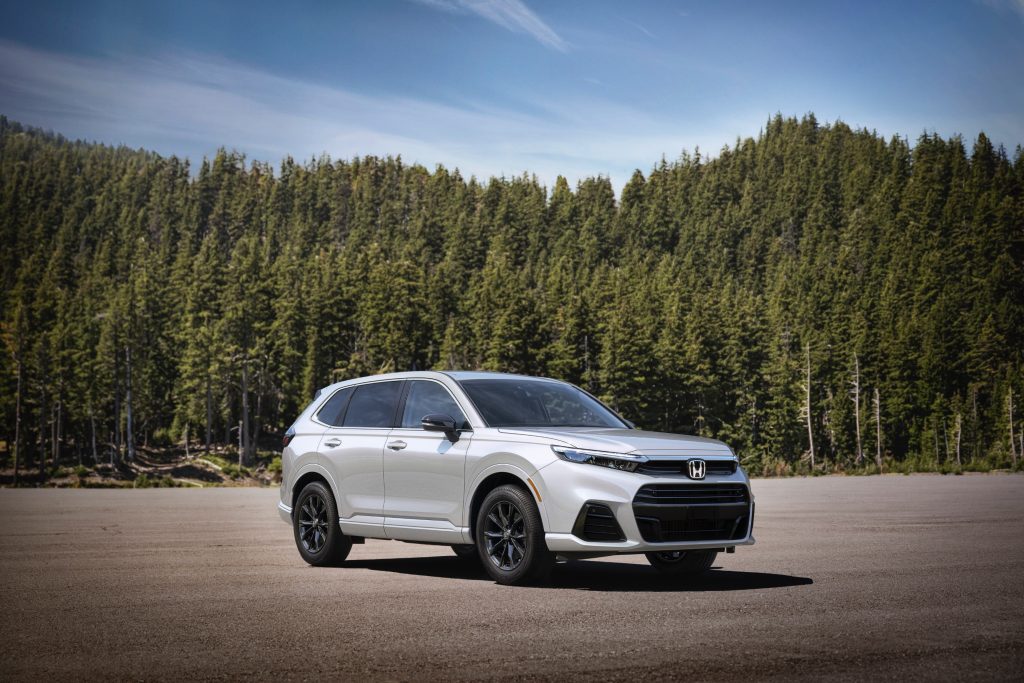
So it’s really not the time for testing the market, for attempting to build demand, for pushing a technology that is clearly not the path forward in consumer vehicles. Everyone else has moved on, and BEVs are selling in the millions, monthly, and Honda is still futzing around with science projects.
Top comment by FC
Hydrogen is not going anywhere. Shell just closed their entire California hydrogen refueling network eliminating nearly 1/3 of the hydrogen stations in California overnight. Hydrogen requires tons of energy to produce and operates at only about 20% “well to wheel” efficiency. Until hydrogen fusion is a legitimate and viable source of limitless power there is no hope for inexpensive hydrogen.
The industry, and the world, need bigger efforts than this. California-only, lease-only vehicles available in the hundreds are so 2012.
But at least the Prologue exists, an EV that will be sold in significant numbers, and with a more EV-focused philosophy behind it – less of a direct translation from a gas hybrid vehicle. Honda (along with Nissan) does seem more realistic about EVs than some of its Japanese counterparts, particularly under Mibe’s leadership.
And so, all of this means that we struggle to find the importance of the e:FCEV program. While a plug-in fuel cell vehicle is a neat first that does offer better synergies than a gasoline plug-in hybrid (and frankly, we’re amazed nobody thought of this before, it seems obvious in retrospect), the e:FCEV is still steeped in the philosophy of gas vehicles, and of dipping one’s toe in the water, when everyone else at the pool party has been having a great time for a decade now.
The Honda CR-V e:FCEV will be available later this year as a lease-only vehicle, in California only. Pricing has not yet been announced.
FTC: We use income earning auto affiliate links. More.


Comments